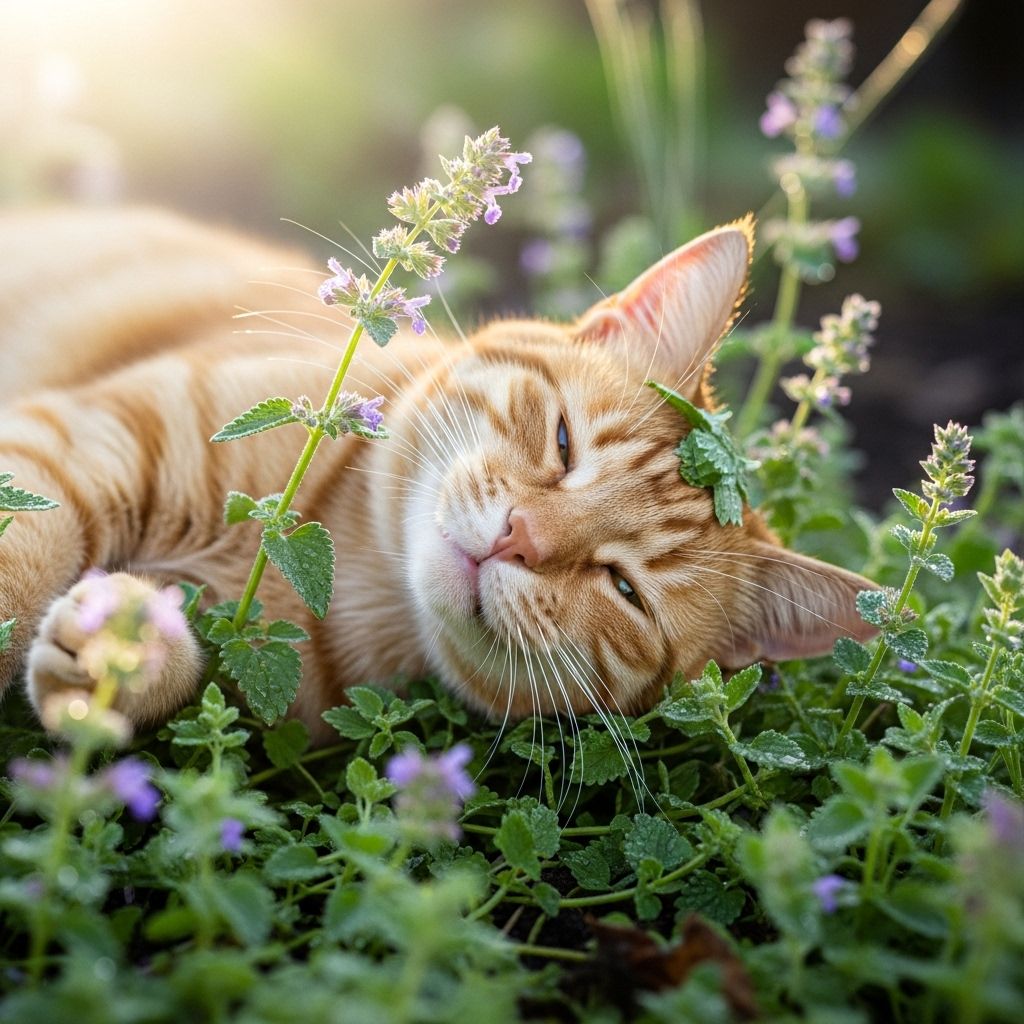Catnip For Cats: Everything You Need To Know
Delve into the origins, effects, and secrets of catnip—how it fascinates felines and its many uses in your cat’s life.

Image: HearthJunction Design Team
What Is Catnip?
Catnip, scientifically known as Nepeta cataria, is an herbaceous plant belonging to the mint family, Lamiaceae. Native to Europe, Asia, and now widespread in North America, catnip features light-green foliage and delicate lavender flowers. This herb is easy to grow at home and has been valued not just for its effects on cats, but also for its historical use in herbal teas and even as a natural insect repellent.
- Plant Family: Mint (Lamiaceae)
- Common Features: Light-green leaves, lavender flowers
- Uses: Cat enrichment, teas, natural bug sprays, folk remedies
Key Takeaways
- Catnip is a potent herb affecting feline behavior when smelled.
- Approximately 60% of cats have a genetic predisposition to respond to catnip, displaying a range of behaviors.
- Effects can include happiness, hyperactivity, calmness, or even temporary aggression in some felines.
How Does Catnip Affect Cats?
The magic of catnip lies in an oil found in the plant’s leaves, stems, and seeds, called nepetalactone. When a cat encounters catnip—typically through sniffing, licking, rubbing, or rolling—the nepetalactone vapor stimulates special olfactory receptors in the cat’s nose.
Cats possess a unique scent organ called the vomeronasal gland (sometimes called Jacobson’s organ), located in the roof of their mouth. This gland channels scent molecules straight to the brain, bypassing the usual scent-processing pathways and leading to the classic “catnip high.”
- Nepetalactone: The key compound that triggers the feline response.
- Vomeronasal gland: Specialized sensory organ amplifying reactions to catnip’s scent.
Typical Catnip Behaviors
- Rolling, flipping, and rubbing on surfaces or toys containing catnip
- Purring, vocalizing, or sudden bursts of playful activity
- Occasional meowing or growling
- Some cats may become calm or even slightly aggressive for a short period
The Science Behind Catnip’s Effects
Studies suggest that when a cat inhales nepetalactone, it binds to receptors in the feline nose. These signals travel to the brain, particularly to parts responsible for controlling emotions and behaviors. The effect is believed to resemble a type of temporary euphoria, often likened to a mild high that dissipates after a few minutes. Importantly, catnip works through the cat’s internal opioid system, releasing endorphins that promote feelings of pleasure and well-being.
Interestingly, the behavior produced by catnip is not due to a true drug-like intoxication, since catnip acts on different neural pathways compared to substances like alcohol or narcotics in humans. After exposure, cats typically lose sensitivity to catnip for a while and need a “reset” period of around 10–15 minutes before they can respond to it again.
Why Are Some Cats Not Affected by Catnip?
Not every cat falls under the spell of catnip. In fact, catnip sensitivity is a hereditary trait determined by a specific gene. Around one-third of all cats lack this gene and will not respond to catnip at all. Age plays a role as well—kittens under three months old typically show no interest, and many don’t develop responsiveness until they’re about six months old. Older cats often display less enthusiasm, as their olfactory senses can diminish with age.
- Genetic Factor: Approximately 33–40% of cats lack the “catnip gene.”
- Age Factor: Kittens and elderly cats often don’t respond.
- Species Specificity: Big cats (like lions or tigers) may respond to catnip, but studies show mixed results.
Other Plants Like Catnip
Catnip isn’t the only plant that can send felines into ecstasy. Silver vine (Actinidia polygama) and valerian root (Valeriana officinalis) contain similar compounds called iridoids, which can also produce euphoria in sensitive cats. Silver vine contains a compound known as nepetalactol, chemically similar to nepetalactone, which some studies have found to be even more attractive to cats.
- Silver vine (Actinidia polygama): Stronger effect on some cats than catnip
- Valerian root (Valeriana officinalis): Has a musky smell, stimulates some cats unresponsive to catnip
- Tatarian honeysuckle: Another alternative for enrichment
Forms of Catnip: Which Is Best?
Catnip comes in various forms to suit every feline preference and household:
- Dried leaves: The most common form used in toys and for sprinkling on scratching posts
- Fresh catnip: Growing the plant at home provides the freshest experience
- Catnip sprays: Convenient for refreshing toys and bedding
- Catnip-infused toys: Toys stuffed with dried catnip or catnip oil
- Catnip treats: Edible treats made with catnip flavoring (effects are generally milder than those produced by inhalation)
All forms are generally safe, and there is no difference in intensity of the physical or behavioral reaction based on the catnip’s form; the key is the presence and freshness of nepetalactone.
How Long Do Catnip Effects Last?
The typical behavioral response to catnip lasts about 10–15 minutes. Afterwards, cats often become temporarily immune to its effects and may not respond again until after a “cool-down” period of at least 30 minutes to a few hours.
Is Catnip Safe for Cats?
- Catnip is non-toxic and safe for cats in all forms.
- Cats can’t overdose on catnip. Even if they eat or sniff a large amount, the body will naturally regulate the response, and excess is usually ignored.
- Rarely, some cats may become overstimulated, resulting in transient aggression or hyperactivity.
- Ingesting large quantities could lead to mild stomach upset or diarrhea, but these symptoms are rare and not dangerous.
Benefits of Catnip
- Enrichment: Enhances play behavior, mental stimulation, and exercise.
- Stress Reduction: Some cats become more relaxed, helping in stressful environments or when transitioning to new homes.
- Training Aid: Encourages use of scratching posts or beds by sprinkling catnip on them.
- Socialization: Can improve social play between cats, but monitor for overstimulation.
Potential Drawbacks and Precautions
- Monitor play if giving catnip to multiple cats at once, as excitement may lead to minor skirmishes.
- For cats with a history of aggression, avoid catnip or use only under supervision.
- Avoid giving catnip daily; regular rotation helps maintain interest and prevents habituation.
Catnip for Humans and Other Uses
Humans have historically used catnip in teas for its mild sedative properties, as well as in folk remedies to soothe coughs or as a natural insect repellent. However, catnip’s effects on humans are much subtler than those seen in cats and should not be expected to produce a “high.”
Table: Common Catnip Forms and Uses
| Catnip Form | Best Use | Notes |
|---|---|---|
| Dried Leaves | Sprinkle on toys or scratch posts | Most common and cost-effective |
| Fresh Catnip Plant | Grown at home for play & snacking | Requires sunlight and moderate watering |
| Catnip Spray | Refresh toys, bedding, or posts | Convenient; less messy than leaves |
| Catnip Toys | Interactive play | Varies in potency; replace when scent fades |
| Catnip Treats | Occasional edible reward | Milder effect than inhaled catnip |
Frequently Asked Questions (FAQs)
Q: Why do some cats not react to catnip?
A: Sensitivity to catnip is a hereditary trait, and about one-third of cats lack the gene needed to respond. Kittens and many older cats also typically show no response.
Q: Can cats overdose on catnip?
A: No, cats cannot fatally overdose on catnip. Consuming a large amount may cause mild digestive upset, but serious harm is extremely unlikely.
Q: Are there alternatives to catnip for cats that don’t respond?
A: Yes! Silver vine, valerian root, and Tatarian honeysuckle can evoke similar playful or calm behaviors in many cats that don’t react to catnip.
Q: How should I introduce catnip to my cat?
A: Start with a small amount of dried catnip on a favorite toy or scratching post. Observe your cat’s reaction before increasing frequency or quantity. Always supervise the first few sessions to gauge their response.
Q: Does catnip work on kittens?
A: Most kittens show little to no interest in catnip before about three to six months of age; many don’t develop sensitivity until adolescence.
Q: Is catnip addictive for cats?
A: Catnip is not addictive. Cats may become less responsive with frequent exposure, so cycling its use helps maintain its novelty and effect.
Conclusion
Catnip remains a fascinating natural enrichment for felines and a valuable tool for both entertainment and training. If your cat enjoys catnip, it can be a safe and effective way to encourage play, reduce stress, and provide mental stimulation. For those cats who don’t respond, there are other equally engaging alternatives. Always observe your cat’s individual preferences and reactions to make playtime as enjoyable as possible!
References
- https://www.petmd.com/cat/general-health/what-is-catnip
- https://www.petmd.com/cat/general-health/does-catnip-make-cats-high
- https://www.science.org/content/article/why-cats-are-crazy-catnip
- https://www.webmd.com/pets/cats/catnip-effects-on-cats
- https://www.4pawsanimal.com/services/cats/blog/catnip-and-your-cat-what-it-what-it-does-and-why-it-doesnt-affect-all-cats
Read full bio of Srija Burman












